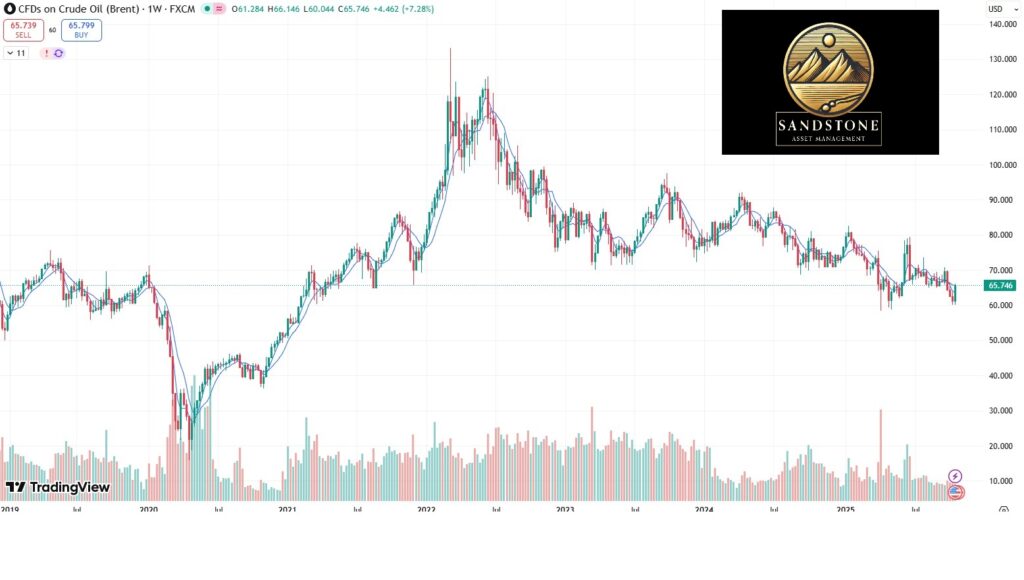
Oil prices surged nearly 5% on Thursday, October 23, 2025, following the imposition of new U.S. sanctions on Russia’s two largest oil companies and amid escalating Ukrainian drone strikes on energy infrastructure.
Benchmark U.S. crude climbed 4.9% to $61.35 per barrel, while Brent crude rose about 5.4% to nearly $66 a barrel.
This spike reflects heightened market concerns over potential disruptions to global oil supplies, as traders react to the dual pressures of geopolitical sanctions and military actions targeting Russia’s energy sector. The rally also lifted shares in major oil companies, with Exxon Mobil, BP, and Shell seeing gains as investors anticipated tighter supply conditions.
European natural gas prices climbed more than 3%, underscoring the broader ripple effects on energy markets.
Trump’s Latest Sanctions: A Sharp Escalation
In a significant policy shift, President Donald Trump announced sanctions on Rosneft and Lukoil—Russia’s two biggest oil producers—on October 22, 2025, aiming to degrade Moscow’s revenue streams funding its ongoing war in Ukraine.
The U.S. Treasury Department described the measures as an effort to “increase pressure on Russia’s energy sector and degrade the Kremlin’s ability to raise revenue for its war machine.”
This marks the first time the U.S. has directly targeted these oil giants over the conflict, following failed talks with Russian President Vladimir Putin.
The sanctions prohibit U.S. entities from dealing with Rosneft and Lukoil, potentially forcing Russia to offer deeper discounts on its oil exports to offset risks for buyers.
Analysts warn that while these measures will hurt Russia’s economy—where oil and gas taxes account for about a quarter of federal revenue—they may not be sufficient to force an immediate ceasefire.
Previous sanctions have been cautious to avoid global economic fallout, but this step signals a more aggressive U.S. stance.

🚨 China’s Big Four Cut Russian Oil Purchases After U.S. Sanctions 🇨🇳🛢️
China’s state oil giants @SinopecNews , @PetrochinaID , @CnoocSes , and Zhenhua Oil have suspended or sharply cut seaborne Russian crude after Washington’s new sanctions on #Rosneft and #Lukoil.
Sinopec’s… pic.twitter.com/zEng22HOTM
— Jack Prandelli (@jackprandelli) October 23, 2025
Global Market Impact and the Shadow Fleet’s Role in Evasion
The sanctions have reignited fears of supply disruptions, contributing to today’s price jump.
Russia’s oil exports, which have remained resilient despite earlier restrictions, could face new hurdles, particularly for major importers like India and China.
However, Moscow has long relied on a “shadow fleet” of aging tankers to evade Western sanctions, employing deceptive tactics such as ship-to-ship transfers at sea, falsified documentation, and disabling tracking systems.
A key evasion method involves misreporting or overstating cargo details to skirt price caps imposed by the G7, which limit Russian crude to $60 per barrel for Western-insured shipments.
This shadow fleet, often uninsured or under opaque ownership, has allowed Russia to maintain exports but at higher costs and risks, including environmental hazards from poorly maintained vessels.
Recent U.S. actions aim to crack down on these practices, potentially increasing shipping expenses for Russia and further straining its war economy.
Globally, this could lead to volatile prices, with some analysts predicting sustained upward pressure if enforcement tightens.
History of Ukrainian Drone Strikes on Energy Assets
Ukraine’s drone campaign against Russian energy infrastructure has intensified since early 2025, complementing the sanctions’ economic pressure with direct military disruption. Since August 2025 alone, Ukraine has launched at least 58 drone attacks on key Russian sites, including refineries and export terminals, traveling up to 2,000 km deep into Russian territory.
These strikes have crippled about 10% of Russia’s refining capacity, leading to fuel shortages and reduced revenues for Moscow’s war efforts.
Notable incidents include a record 14 refinery attacks in August 2025 and eight in September, targeting facilities that produce gasoline and diesel.
Recent hits, such as the October 23 strike on the Ryazan Oil Refinery, have caused major blazes and operational halts.
Ukraine’s strategy focuses on the arms and oil industries, with drones responsible for over 65% of destroyed Russian military assets in some estimates.
The campaign has spilled over to neighboring countries with Russian-linked assets. In Hungary, Ukrainian strikes on the Druzhba pipeline in August 2025 suspended oil flows to Hungary and Slovakia for at least five days, prompting Budapest to blame Kyiv and ban a Ukrainian drone commander from entering the country.
Explosions at a Hungarian refinery tied to Russian interests occurred on October 20, 2025, halting operations.
Similarly, in Romania, blasts hit a refinery with Russian connections on the same day, raising questions about attribution amid heightened regional tensions.
These incidents highlight Ukraine’s broadening “drone sanctions” approach, aimed at economically isolating Russia beyond traditional Western measures.
What This Means for U.S. Investors
For U.S. investors, the combination of sanctions and drone strikes presents both opportunities and risks. Higher oil prices could boost profits for domestic energy firms, with recent Ukrainian attacks potentially enhancing global refining margins by reducing Russian exports of refined products.
U.S. refiners stand to gain from tighter supply, as evidenced by today’s stock gains in the sector.
However, prolonged volatility might pressure broader markets if energy costs rise, affecting industries like transportation and manufacturing. Investors should monitor enforcement of sanctions, as effective implementation could further degrade Russia’s output—estimated at a 400,000 barrel-per-day drop in September 2025 due to strikes—potentially benefiting U.S. shale producers.
One of the key things that private investors look to do is invest as close to the wellbore as possible. Meaning that if the private driller is offering investment opportunities, investors can actually make money and good returns at even lower oil prices, with tax advantaged investments. Some go over the 90% to 95% tax deduction range.
India’s Response: A Pivot Away from Russian Crude
India, one of Russia’s top oil buyers since the war began, is responding swiftly to the new sanctions. Major Indian refiners, including Reliance Industries, are preparing to halt or sharply reduce imports from Rosneft and Lukoil to avoid U.S. penalties, with flows potentially dropping to near zero.
This shift could disrupt India’s energy lifeline, as Russian crude has accounted for a significant portion of its imports at discounted rates.
Sources indicate refiners are reviewing contracts and seeking alternatives from the Middle East or the U.S., amid fears of secondary sanctions.
While this may increase India’s import costs, it underscores the diplomatic tensions, with the U.S. reportedly threatening 50% tariffs on Indian goods if purchases continue.
India’s move could further isolate Russia economically, amplifying the sanctions’ global impact.
As the situation evolves, Energy News Beat will continue monitoring these developments and their implications for the global energy landscape.
Got Questions on investing in oil and gas? Or do you have a Tax Burden in 2025?
Crude Oil, LNG, Jet Fuel price quote
ENB Top News
ENB
Energy Dashboard
ENB Podcast
ENB Substack





